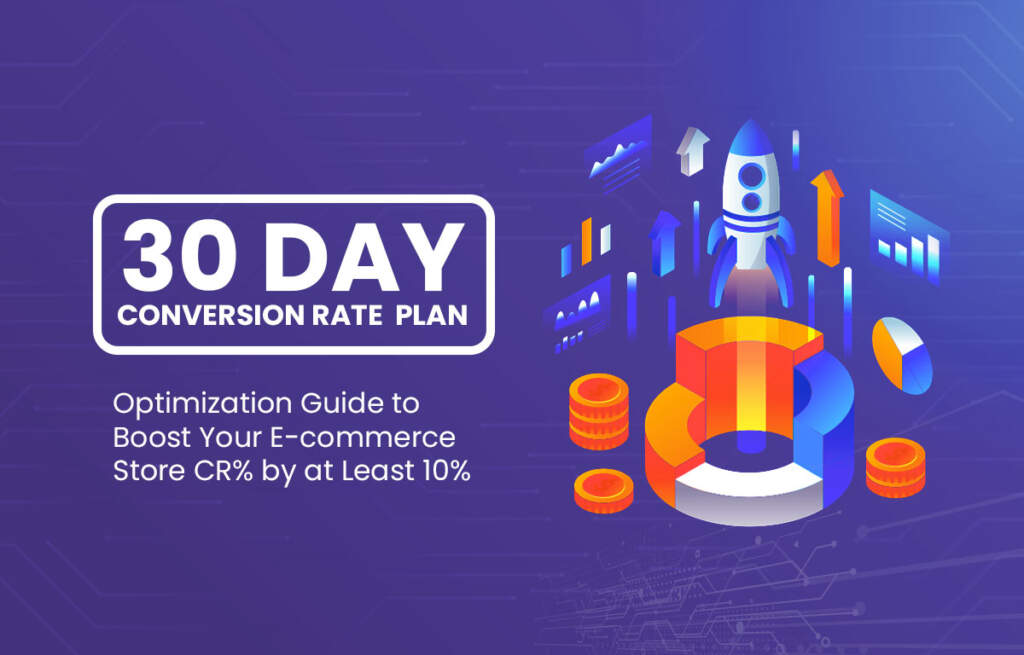As an e-commerce business, you must build brand awareness and attract traffic. One important element that helps boost your e-commerce is conversion rate optimization (CRO). It’s essentially the technique to increase the number of website visitors to take action on your website. So, increasing CRO implies more chances of customers making purchases, earning more revenues, etc.
Read on to delve into how to plan key tasks such as improving website performance, optimizing your product pages, deploying a streamlined checkout process, and more. The article outlines these and other activities as a part of a 30-day plan for conversion rate optimization, splitting the most elaborate components into periods of 4 weeks with tasks listed out for each week. The other tasks can be clubbed with any of these major activities and performed.
Important Aspects to be Considered to Boost Your E-commerce Store CR%
Website performance and a hassle-free shopping experience are key pillars of the e-commerce business. Quite often, users find it frustrating when the website takes too much time to load, and they leave it mid-way. To avoid such problems, enhancing website performance is a crucial step towards conversion rate optimization. Follow the below steps to boost your e-commerce store CR%.
Week 1
- Check the sizes of images on your website pages.
- Make a note of those images with respective pages which are larger. Large images tend to slow down the website loading time.
- Decide on the strategy to prioritize which pages need to be handled first.
- Use tools like JPEG optimizer or Tiny PNG to compress these images.
- Once done, reload them into your website and observe the website's performance.
Week 2
- Focus on improving your website loading speed.
- Optimize your code, ensuring it is free of errors or bugs.
- Test your code multiple times to confirm its accuracy.
- Make use of Javascript files to cut down on browser requests.
- Ensure all the coding is updated and efficient.
Week 3
- Choose the appropriate web hosting service with a quick server response.
- Do check the extent of website traffic that the server can handle.
- If you wish to have a global presence, install a content delivery network.
Week 4
- Optimize the above steps to monitor and assess your website's loading time and speed.
Optimize your Product Details Pages (PDPs)
E-commerce websites attract customers only when they offer a rewarding experience. Clear instructions to navigate, easy shopping options, well laid-out product descriptions - all and more contribute to boosting your e-commerce store CR%. Product pages that lack adequate and clear information could turn away your potential customers, that's why it's important to optimise your product pages. These could be considered as your "money pages" and it's where the final decision to purchase is made in your customers' mind.
Follow the 30-day plan outlined here:
Week 1
- Revisit all your website pages in detail, one by one.
- Include clear product descriptions, features, and use cases across the pages.
- If you find certain product pages lack images, do take steps to include relevant ones.
Week 2
- Focus on each product and think of ways to highlight their benefits.
- Include appropriate SEO techniques and keywords to boost your e-commerce store CR%.
Week 3
- Images of products must be clear and showcase distinct features.
- Upload the images from different angles and include a 360-degree perspective.
Week 4
- Formulate a transparent pricing strategy.
- Include other robust aspects like testimonials, call-to-action buttons, etc.
- Make sure to keep the interface intuitive and user-friendly.
Adopt a well-crafted checkout process
Customers need your trust and credibility. Everyone expects a smooth and satisfying shopping experience. A long and complex checkout procedure could annoy and stop customers from proceeding. This could, in turn, lead to greater abandonment rates, trust issues, and loss in revenue. Follow the steps outlined as part of the 30-day plan:
Week 1
- Revisit your checkout process thoroughly.
- Include a guest option to allow the scope for those wanting a speedy checkout.
Week 2
- Show the progress indicator bar, which indicates a step-by-step way for customers to the final stage in the checkout.
- Include testimonials, endorsements, HTTP certificates, and such to gain customers' trust and make them feel confident.
Week 3
- Keep the process simple and check for any unnecessary steps.
- Don’t include irrelevant mandatory fields on the form, which discourages the user.
Week 4
- Make sure to keep a minimum number of fields for sign-up.
- Provide options to log in through social media or email options.
Include Social Endorsements
As customers trust reviews and feedback from other users, it makes sense to include testimonials on your website. This could significantly boost your e-commerce store CR% and bring in more traffic.
Amazing User Experience
User Experience (UX) is a major determinant of the trustworthiness of your website. Websites with complicated or vague structures confuse the users on how to navigate, deterring them from revisiting. A user-friendly and intuitive user interface that imparts an exceptional user experience is integral to increasing your conversion rate optimization.
Staying Mobile-friendly
Most customers shop and browse your portals on smartphones. Those websites that don’t support mobile apps are often not preferred by customers. Besides, as per research, about three-quarters of Americans buy things online using smartphones. This implies that if you don’t have an app, you lose a major chunk of your potential customers. Making your website responsive and convenient to use, regardless of the device, is important to increase conversion rate optimization.
Providing Personalised Recommendations
Everyone enjoys and expects personalized attention. Personalization entails creating and designing your website pages, colors, and the look-and-feel to offer a pleasing experience to the users. It plays a significant role and could go a long way towards boosting your e-commerce store CR%. In addition, it develops a strong bond between you and the customers, letting them move towards a long-standing association.
Embrace the Psychology of Limited Offers
It’s an old-time trick used by e-commerce businesses worldwide to attract customers by making special offers and providing discounts, coupons, gifts, and more. The concept of scarcity or limited availability induces urgency in customers' minds, moving them toward a purchase decision.
Returns and Refunds
Incorporate the policy of returns, replacements, and refunds. Most customers feel wary of trying out a new product for fear of it not suiting them later or the item being damaged. The policy of getting refunds or a replacement for the unsuitable product relieves their anxiety and lets them whole-heartedly try something new.
This could significantly boost your e-commerce store CR% as more customers would reach out with the idea of buying new items as they feel protected by the returns and refund processes.
Content Marketing Efforts
Content marketing is an important component in enhancing conversion rate optimization. E-commerce businesses can benefit significantly from content marketing, such as brand building, lead generation, creating awareness, attracting customers, better ranking on search engines, enhanced customer engagement, and more.
Week 1
- Chalk out a content marketing plan.
- Decide on what types of content you would require, like blogs, social media, etc.
Week 2
- Hire an in-house content writer or freelancer, depending on your budget.
- Arrange meetings with all team members - writers, editors, and managers to understand the marketing strategy.
Week 3
- Prepare a content marketing calendar using tools like Hubspot, Google Calendar, or Trello.
- Include all types of content formats like infographics, videos, etc.
- Plan the content types according to the buying stages of customers - awareness, interest, etc.
Week 4
- Start publishing your blogs or social media posts periodically.
- Use appropriate software platforms for content distribution like Click to Tweet, Buffer, Wisestamp, etc.
- Deploy tools like Google Analytics to evaluate your marketing efforts.
- Monitor and assess your content marketing metrics continuously.
Wrapping Up
Conversion rate optimization is a key parameter to boost your e-commerce website. This requires you to focus on major tasks, including enhancing website performance, focused content marketing efforts, deploying a streamlined checkout process, a hassle-free and gratifying user experience, and more. Adopt the 30-day plan with the major components segmented into 4 weeks with tasks to be carried out for each week outlined in the article to boost your e-commerce store CR%.


